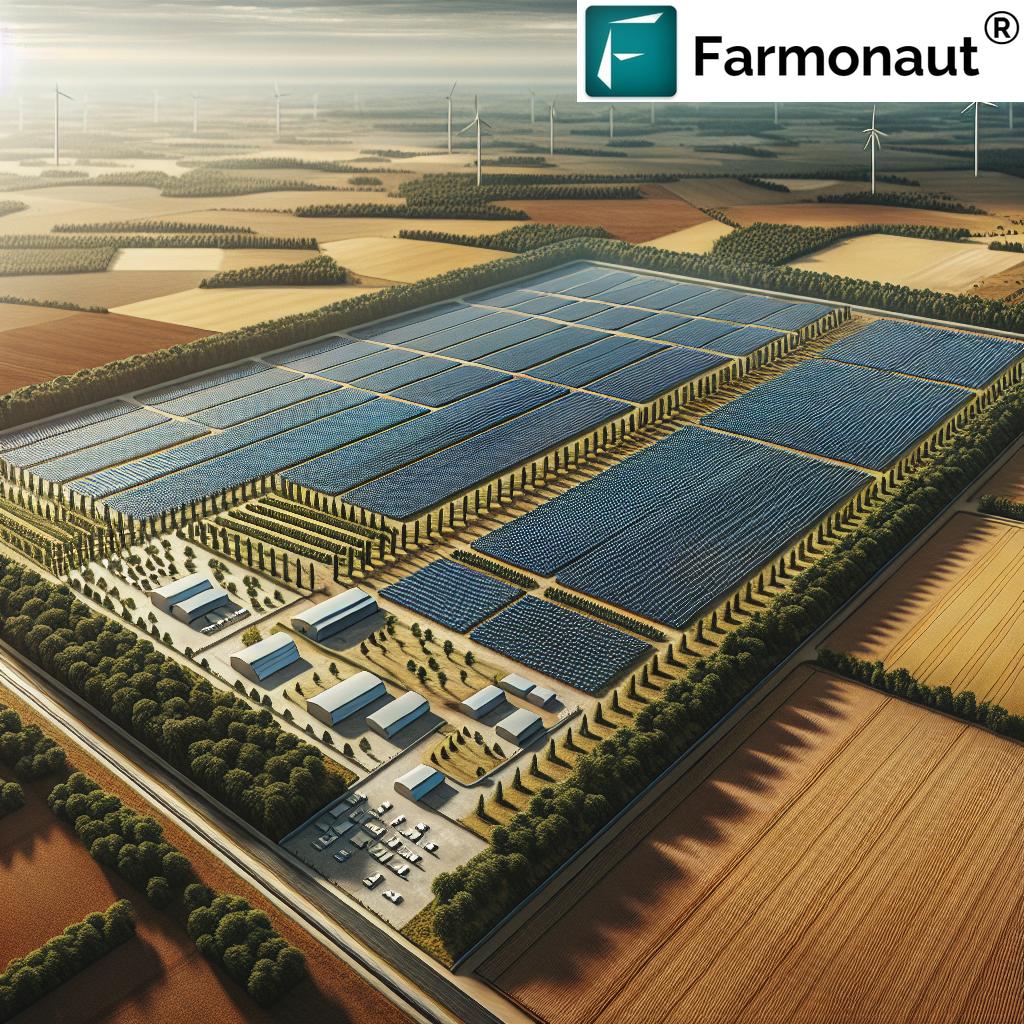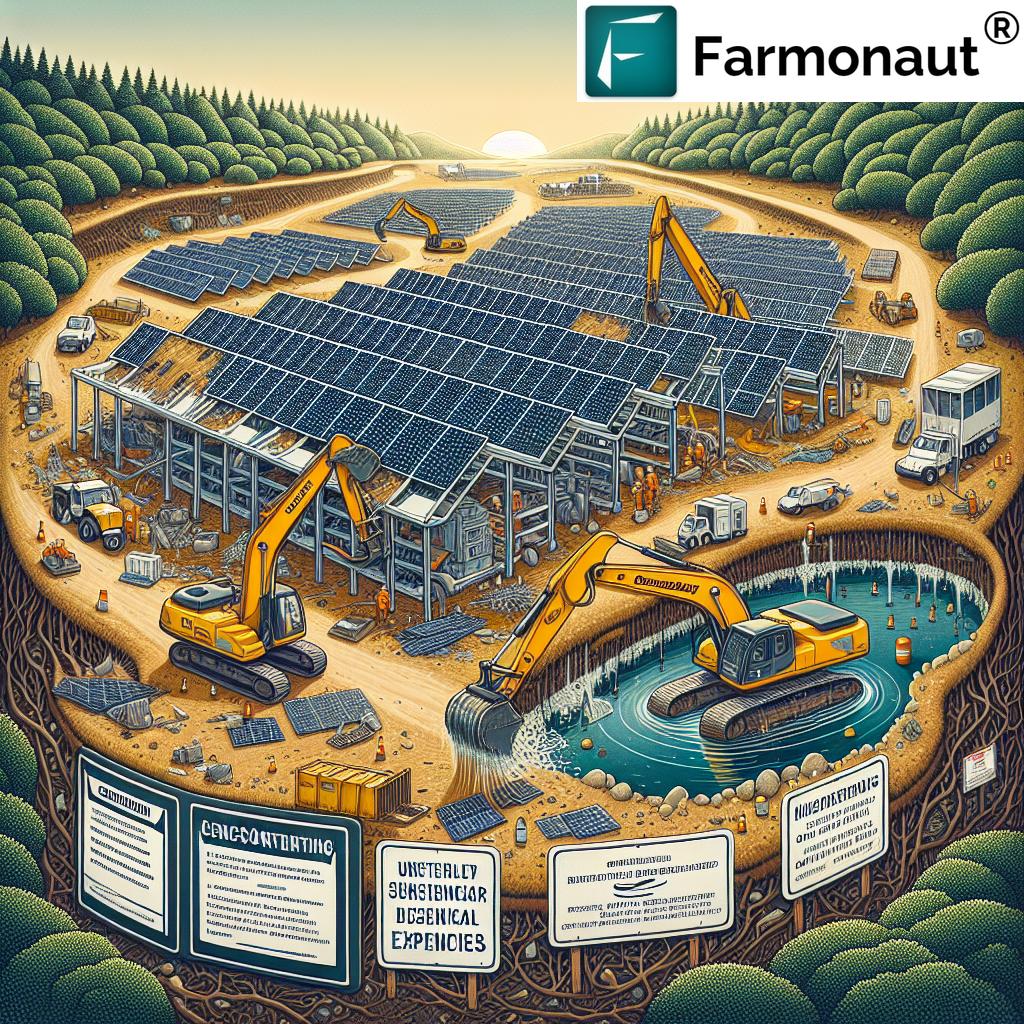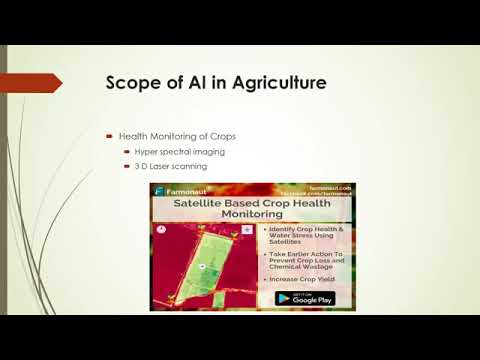Solar Farm Regulations: 7 Crucial Impacts on Northampton County
“Northampton County limits solar farm expansion to just 2% of total agricultural land to protect local ecosystems.”
- Solar Farm Regulations in Northampton County: Overview
- Impact #1: Wildlife Habitat Loss and Environmental Systems
- Impact #2: Soil, Water, and Solar Panel Contamination Risk
- Impact #3: Community Health and Quality of Life
- Impact #4: Effects on Agricultural Sustainability and Land Use
- Impact #5: Solar Farm Expansion Limits and Landscape Changes
- Impact #6: Decommissioning Costs and Adequacy of Regulations
- Impact #7: Local Governance, Moratorium, and Community Trust
- Comparative Impact Table: Solar Farm Regulations in Northampton County
- Farmonaut: Supporting Sustainability with Data-Driven Insights
- Frequently Asked Questions (FAQ)
Solar Farm Regulations in Northampton County: Overview
As we examine the solar farm regulations recently brought to the forefront in Northampton County, it becomes abundantly clear that these rules carry weight far beyond a simple policy discussion. The solar farm moratorium enacted by the County Board not only freezes new projects until July 2025 but also opens the door for a much-needed reassessment of how large-scale solar facilities impact our community, environment, agricultural legacy, and local economy.
Given the significant environmental impact of solar farms, community advocates have voiced that the existing ordinance may not adequately address the risks related to expansion, decommissioning, and sustainability. This blog post dives deeply into the seven most crucial impacts of the evolving solar farm regulations and brings forward vital insights on agriculture, community welfare, environmental contamination risks, and the path to a sustainable Northampton County.
With community presentations expressing concern over issues like deforestation, soil erosion, water contamination, and the fate of farmland, the conversation around solar farm regulations is more crucial—and more local—than ever. Below, we explore in detail how each regulatory aspect profoundly shapes the future of Northampton County, with reference to citizen feedback, county meetings, and the implications of current and proposed policy choices.
Impact #1: Wildlife Habitat Loss and Environmental Systems
Deforestation, Fencing, and Wildlife Displacement
A primary concern of solar farm expansion in Northampton County is the impact on local wildlife habitats. Regulations—or a lack thereof—directly shape how much native forest and open land is cleared, thus affecting local biodiversity. Utility-scale solar facilities often require the removal of large stretches of trees (deforestation), leveling of fields, and installation of fencing. This results in multiple cascading effects:
- Habitat removal forces animals to move into populated areas, increasing the risk to both wildlife and human residents.
- Fencing not only blocks animal movement but also their access to food and water (noted as a problem near both Roanoke Rapids Dam and Gaston Dam, where large solar facilities are currently built).
- For birds, solar panels can be mistaken for bodies of water, leading to fatal errors and population declines.
From an environmental impact perspective, solar panel fields—when improperly regulated—cause lasting changes to the native landscape. This starts a domino effect impacting every aspect of the ecosystem. Expansion limits, buffer zones, and mandatory wildlife surveys in the solar farm regulations could offer meaningful mitigation if strictly enforced.
Impact #2: Soil, Water, and Solar Panel Contamination Risk
Soil Erosion, Water Pollution, and Chemical Use
Large solar fields require extensive land clearing, increasing the risk of soil erosion. When vegetation is removed, the soil’s capacity to absorb rain diminishes. This leads to greater runoff into nearby water bodies—a particular concern around the Roanoke Rapids Dam and surrounding wetlands.
Moreover, solar farm construction and ongoing operations often rely heavily on the use of chemicals for weed and vegetation control:
- These chemicals can seep into the soil, potentially contaminating groundwater supplies.
- If solar panels are damaged or improperly maintained, toxic by-products can leak, compounding the solar panel contamination risk.
- Improper decommissioning raises the specter of long-term environmental contamination, especially if panels are not correctly recycled.
The latest discussions at the county board meetings suggest a significant push for strict enforcement of pollution controls within the ordinance to minimize risk and protect local water sources.
Impact #3: Community Health and Quality of Life
Air Quality Degradation and Mental Well-Being
The influence of solar farm construction is felt acutely by local residents. One of the most direct impacts stems from burning debris during land clearing, which creates considerable smoke that drifts into neighborhoods. Community members have shared that plumes of smoke can linger for days, forcing people indoors and raising legitimate questions about air quality.
- Prolonged smoke exposure can trigger respiratory issues, especially for sensitive groups such as children and the elderly.
- The loss of quiet, rural landscape due to the arrival of industrial-scale facilities can negatively affect mental well-being, sense of place, and the rural heritage of Northampton County.
Both of these factors point toward a growing need for regulations that prohibit burning debris and safeguard health during and after construction. This is particularly relevant as the solar industry continues to outpace local research and regulatory agility.
“Over 60% of Northampton residents express concern about solar farms’ impact on farmland and community sustainability.”
Impact #4: Effects of Solar Farms on Agriculture
Competition for Land, Loss of Farmland, and Community Economics
The effects of solar farms on agriculture are among the most significant—yet often overlooked—consequences of rapid expansion. Many Northampton families have relied on the land for generations, with farming forming the economic and cultural foundation of the area.
- Leasing land for solar farm use reduces the acreage available for food production and livestock, impacting both local food security and the economic stability of farming families.
- The construction of large solar facilities diminishes prospects for young farmers to take over or start new agricultural ventures.
- Expansion without sufficient limits can drastically reshape the rural economy, replacing jobs and income streams that would otherwise remain in the local area.
Residents have also pointed out that power produced in Northampton—often under long-term contracts to distant corporations—does not directly benefit the community in terms of reduced energy costs or improved infrastructure. As stipulated at the county board meeting, there’s pressing need for regulations that guarantee real, local community benefits if continued expansion is to take place.
Impact #5: Solar Farm Expansion Limits and Landscape Changes
Setting Limits and Preserving Rural Identity
By limiting total solar farm expansion to just 2% of the county’s agricultural land, Northampton seeks to prevent its landscape from turning into a patchwork of industrial energy sites. This regulatory aspect recognizes several critical factors:
- Preserving the landscape ensures that future generations inherit a region with genuine agricultural utility, aesthetic beauty, and environmental function.
- Expansion limits protect the long-term sustainability of the ecosystem, including natural drainage patterns, wildlife corridors, and habitats.
- Setting thresholds in the ordinance provides a clear mechanism to pause, reassess, and enforce smart growth across the area.
This policy also amplifies the community’s voice by requiring regular public meetings and input before significant new expansion projects are approved. The current moratorium, which runs until the end of June 2025, reflects a growing consensus on the importance of carefully evaluating cumulative effects before proceeding.
Impact #6: Solar Farm Decommissioning Costs and Adequacy of Regulations
Financial and Environmental Responsibility
A significant concern put forward by both residents and sustainability experts is the future cost and risk of solar farm decommissioning. With estimates reaching as high as $250,000 per 1,000 acres, the question of who bears the financial burden is critical—not only for the local government but for every taxpayer, farm owner, and neighbor.
- Current regulations often fall short in specifying how decommissioning should be funded and enforced.
- Recycling panels is costly and not always available; disposing of them in landfills is not sustainable from an environmental perspective.
- The potential for abandoned sites increases without clear, binding decommissioning rules in the county ordinance.
Both the community and local agricultural leaders have stressed the importance of requiring developers to post bonds or insurance to cover the full cost of decommissioning from the outset. Such financial mechanisms would drastically reduce taxpayer exposure and help ensure proper reclamation of the land.
Impact #7: Local Governance, Moratorium, and Community Trust
Ensuring Transparent, Community-Driven Regulation
Effective solar farm regulations must be anchored in trust and informed oversight. Northampton County’s recent move to enact a solar farm moratorium showcases both the urgency of the issue and the importance of involving citizens in shaping the rules that will guide their environment for years to come.
- Community input is now solicited at public meetings, with presentations highlighting gaps in current law and areas for improvement.
- Local advocates have cautioned against relying on potentially biased sources like C4EE (Center of Energy Education), emphasizing the value of impartial legal and environmental advisors.
- The moratorium gives the board and its planning staff the opportunity to gather research, conduct environmental studies, and propose vital updates to the county’s solar ordinance.
For municipalities weighing future solar development, Northampton’s current experience offers a roadmap for responsible, transparent, and sustainable regulation—grounded in the lived experiences of citizens and the expertise of environmental scientists.
Comparative Impact Table: Solar Farm Regulations in Northampton County
| Regulatory Aspect | Description of Regulation | Estimated Impact on Agriculture | Estimated Community Impact | Sustainability Implications |
|---|---|---|---|---|
| Land Use Restriction (2% Cap) | Limits total solar farm coverage to 2% of agricultural land | Reduces available farmland significantly; estimated loss of hundreds of hectares but preserves majority for agriculture | Minimizes neighborhood encroachment; preserves community character | Ensures long-term food security and landscape preservation |
| Buffer and Wildlife Corridor Regulations | Mandates wildlife survey, corridor maintenance, and setback from critical habitats | Protects adjacent cropland from runoff/wildlife loss | Reduces human/animal conflict in residential areas | Supports biodiversity and ecosystem resilience |
| Water Runoff and Soil Erosion Controls | Requires vegetative buffers, stormwater management, erosion control plans | Prevents degradation of adjacent farmland via sedimentation | Improves water quality for residents and farms nearby | Reduces soil loss, maintains watershed health |
| Chemical Use Regulation | Limits or bans herbicide/pesticide use for weed control on solar sites | Prevents cross-contamination with crops/soil | Safer drinking water, lower health risks for community | Reduces risk of long-term soil and water contamination |
| Burning and Debris Management Ban | Prohibits burning of brush/debris during construction | Better air for farm workers/adjacent crops | Safer air quality in neighborhoods | Minimizes greenhouse gas spikes from clearing |
| Decommissioning Funding Requirement | Mandates bonds or financial surety for full decommissioning cost | Restores land to prior agricultural use post-lease | Prevents abandonment; reduces taxpayer liability | Ensures long-term sustainability, avoids landfill waste |
| Community Benefit Agreements | Requires local hiring, transparent power contracts, or community investment | May indirectly support local agricultural infrastructure | Increases local economic returns, fairer resource distribution | Aligns solar expansion with sustainable, equitable growth |
Farmonaut: Supporting Sustainability with Data-Driven Insights
Effective land use, environmental stewardship, and sustainable agriculture hinge on our ability to gather timely data, monitor changes, and make evidence-based regulatory decisions. Here is where Farmonaut—an advanced agricultural technology company—empowers farmers, researchers, policymakers, and agricultural businesses:
- Satellite-Based Crop Monitoring: Using multispectral satellite imagery, Farmonaut tracks crop health, vegetation, and carbon footprint across vast fields—critical for assessing landscape changes due to solar farm expansion or decommissioning.
- Resource & Fleet Management: Farmonaut simplifies logistics for large and small farms, improving efficiency and sustainability. Discover its fleet management solutions, which optimize downtime and reduce operational costs for agricultural businesses.
- AI-Based Advisory Systems: Real-time, satellite-driven advice delivered through web, Android, and iOS apps (see download links above) helps ensure timely irrigation, fertilization, and pest control—making local agriculture more resilient amidst land competition.
- Blockchain-Based Traceability: The traceability solutions from Farmonaut chip away at supply chain opacity, adding transparent, data-backed confidence for both companies and end consumers.
- API & Integration: For larger businesses, developers, or researchers who need direct, programmable access to geospatial, weather, and agricultural data, Farmonaut offers an API with comprehensive documentation.
- Financing Support: For farmers needing external financing or insurance, Farmonaut’s platform assists institutions with crop loan and insurance verification powered by satellite data—boosting farmer access while reducing fraud.
Whether for large scale farm management, crop plantation, or forest advisory, Farmonaut democratizes precision agriculture and supports resilient, sustainable communities—especially vital where industries like solar and agriculture compete for resources.
Frequently Asked Questions (FAQ)
-
What is the main goal of the solar farm moratorium in Northampton County?
The moratorium pauses new permit issuance for solar farms through June 2025 to allow the county planning board to research, consult experts, and recommend updates to regulations—ensuring balanced and sustainable solar energy expansion while protecting agriculture, water, wildlife, and community interests.
-
What are the biggest environmental impact concerns with solar farms?
Key concerns include loss of wildlife habitats due to land clearing and fencing, increased soil erosion and runoff, risk of groundwater/soil contamination from chemicals, air quality degradation from burning debris, and improper decommissioning of solar panels leading to pollution.
-
How do solar farms affect agriculture in Northampton County?
Solar facilities reduce available farmland by leasing or repurposing agricultural land, threaten multigenerational farm legacies, diminish opportunities for young or new farmers, and can alter the local economy if unchecked expansion is allowed.
-
Why is decommissioning regulation important for large-scale solar facilities?
Without clear requirements for funding and execution, decommissioned solar sites can become environmental hazards due to abandoned equipment and non-recycled solar panels, potentially contaminating the soil and water. Regulations need to ensure financial responsibility remains with developers.
-
What community benefits do Northampton County residents receive from solar farms?
Currently, direct local benefits such as lower energy bills, local hiring, or shared revenue are minimal. Most of the benefits accrue to landowners signing leases or to outside utility companies. Advocates are asking for stronger benefit agreements in all future regulations.
-
Can technology like Farmonaut help with monitoring and sustainability?
Yes. By leveraging satellite data, real-time monitoring, and AI-powered advisory tools, Farmonaut can support compliance monitoring, track environmental changes, and provide transparent data for both policymakers and the agricultural community. This helps balance sustainability, economic, and ecological needs amid regulatory changes.
-
Where can I access Farmonaut’s services or APIs?
- Web App: launch here
- API access: API endpoint, developer documentation
- Android: Google Play
- iOS: App Store
Conclusion
As solar energy continues to grow, detailed, community-informed solar farm regulations are essential for safeguarding Northampton County’s agricultural traditions, environmental integrity, and long-term sustainability. By adopting best practices—such as limiting expansion, requiring decommissioning funding, and enhancing transparency—local authorities can help ensure that clean energy innovation truly works hand-in-hand with healthy soils, abundant water, thriving wildlife, and strong rural communities.
For those managing or monitoring large-scale agricultural landscapes, modern tools like Farmonaut’s satellite-based platform offer invaluable support, ensuring that changes in land use (solar or otherwise) are tracked, measured, and managed for the benefit of current and future generations. Whether you’re a policymaker, farmer, researcher, or sustainability advocate, your voice—and your vigilance—remain vital as we chart the future of renewable energy in Northampton County and beyond.








